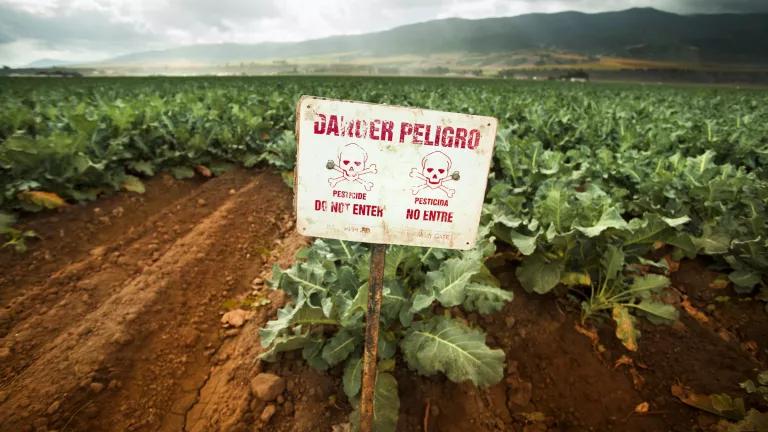National Strategy for Reducing Food Loss and Waste Released
The White House released the final strategy in June 2024, incorporating over 10,000 comments made by the public.

This blog is co-authored with Tori Oto, food waste policy consultant.
Nine years after setting the national goal to halve food loss and waste by 2030, leadership at U.S Environmental Protection Agency (EPA), U.S. Department of Agriculture (USDA), and the Food and Drug Administration (FDA) are identifying opportunities for the federal government to meet this goal through policy, funding, and research. NRDC submitted comments on the draft strategy that encouraged the agencies to take a whole-of-government approach, incorporate stronger reporting mechanisms, and make commitments to lead by example with federal procurement and food loss and waste reduction practices (such as organic waste collection) in federal buildings. The final National Strategy for Reducing Food Loss and Waste and Recycling Organics, released in June 2024, includes many actions that are on the right track to help meet the national goal if implemented effectively, but there is still more to be done.
We are particularly excited to see the following commitments in the final Strategy:
- Lead by Example: The USDA and EPA committed to promoting model food waste prevention, food rescue, and food scrap recycling practices at their headquarters and to explore further opportunities to expand these efforts to other federal buildings across the United States. The EPA’s Environmentally Preferable Purchasing (EPP) Program will also consider recommendations for federal procurement that help prevent food waste, potentially integrating these recommendations into their list of environmentally preferable products and services that all federal agencies must prioritize purchasing when available. Given the sheer size of federal facilities purchasing and managing food, adding food waste reduction to the EPA’s procurement recommendations could have a significant impact.
- Consumer Education and Behavior Change Campaign: The National Strategy commits to develop, launch, and run a national consumer education and behavior change campaign on food waste reduction. This campaign will be based on research and informed by prior efforts in the U.S. and globally. The UK, South Korea, and other countries have demonstrated that coordinated public campaigns to educate consumers on food waste reduction strategies can provide straightforward savings to government agencies, businesses, and consumers.
- Guidance and Other Educational Resources: The National Strategy includes commitments by the agencies to provide educational resources to farmers and insurance agents about gleaning (collecting unharvested food for donation), to expand outreach to businesses about liability protections available for food donation, and to provide education to relevant parties on existing federal food safety protections to process food scraps into animal feed. This guidance is essential for clarifying and furthering these initiatives.
- Food Loss and Waste Data: The EPA committed to integrating new food loss and waste data into the Waste Reduction Model (WARM), which provides information about greenhouse gas emissions reductions and economic impact for materials management practices to help waste management decisionmakers. The EPA also committed to creating a methane emissions savings calculator to help states and municipalities better quantify the methane reductions from reducing food waste.
In addition to these and other critical commitments in the final National Strategy, there is more that still needs to be done. We believe the following actions could make even more progress:
- Whole-of-Government Strategy: We are glad to see the U.S. Agency for International Development (USAID) join the Interagency Collaboration to Reduce Food Loss and Waste and we hope to see additional agencies do the same down the line. Further commitments from these agencies and others to use their authorities and funding to address food loss and waste will move the country significantly closer to meeting the national goal.
- Date Labels: Nearly 10% of consumer food waste is associated with the misinterpretation of date labels. The agencies received nearly 10,000 comments—including from NRDC—to address date labels and in the final strategy they included a commitment to continue to support private efforts to standardize date label terminology and to consider it as a topic for consumer education. We will continue to encourage the agencies to incorporate date label education into their work.
The agencies commit to reporting on progress towards the national goal to halve food loss and waste through the EPA’s Report on the Environment and the annual report entitled Inventory of US Greenhouse Gas Emissions and Sinks. We had hoped to see the agencies commit to an annual report on the strategy’s implementation, but we are glad to see food loss and waste included in these greenhouse gas inventories and reports. We need all hands on deck—including states, municipalities, non-profit organizations, and companies—to achieve progress towards our national goal. NRDC and the Zero Food Waste Coalition will work with the agencies and partners to continue making progress.
This blog provides general information, not legal advice. If you need legal help, please consult a lawyer in your state.



